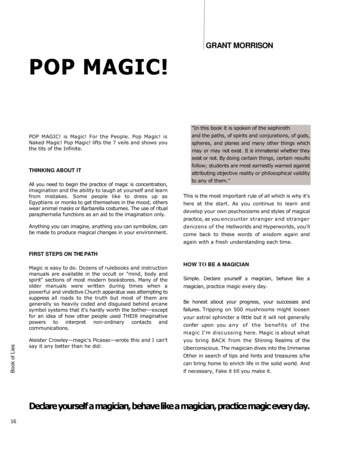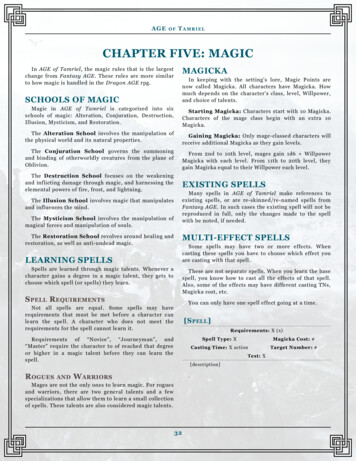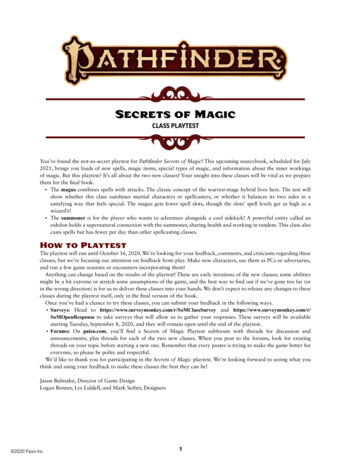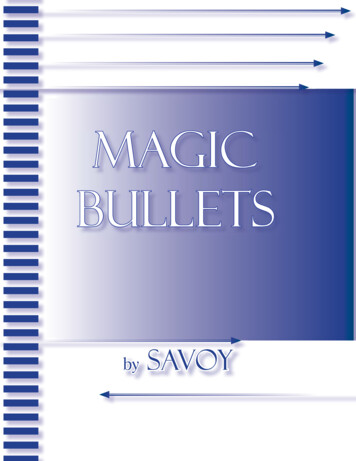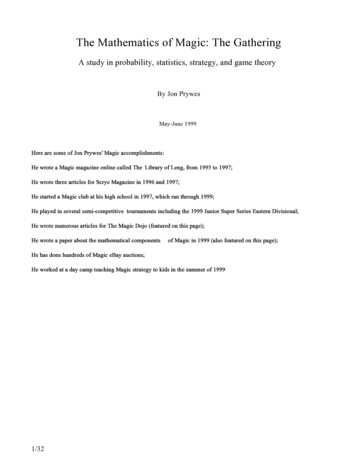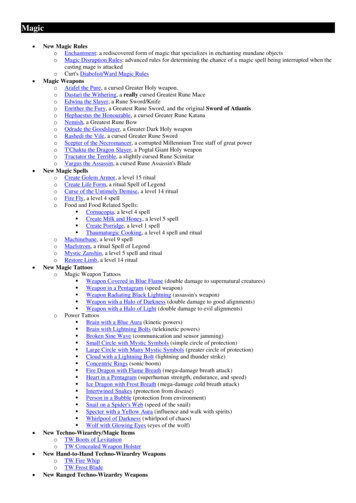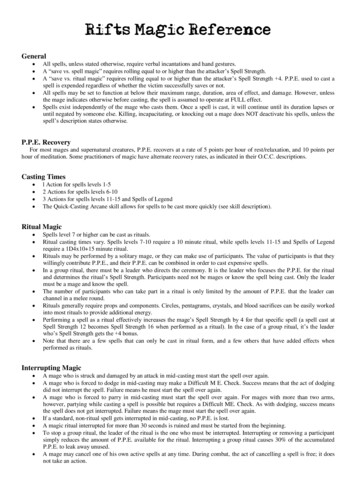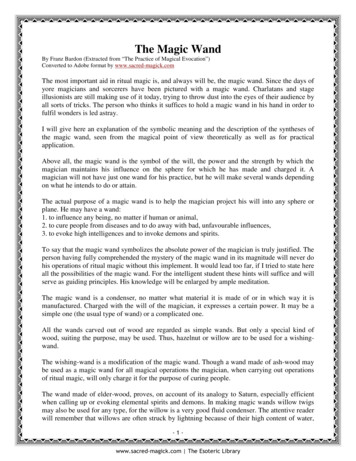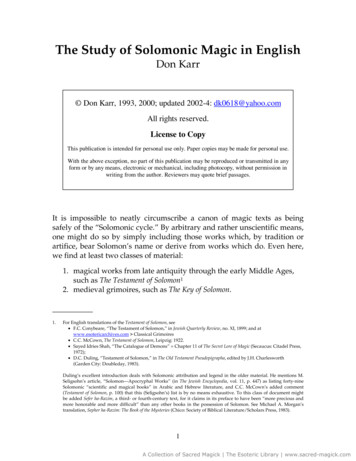
Transcription
The Study of Solomonic Magic in EnglishDon Karr Don Karr, 1993, 2000; updated 2002-4: dk0618@yahoo.comAll rights reserved.License to CopyThis publication is intended for personal use only. Paper copies may be made for personal use.With the above exception, no part of this publication may be reproduced or transmitted in anyform or by any means, electronic or mechanical, including photocopy, without permission inwriting from the author. Reviewers may quote brief passages.It is impossible to neatly circumscribe a canon of magic texts as beingsafely of the “Solomonic cycle.” By arbitrary and rather unscientific means,one might do so by simply including those works which, by tradition orartifice, bear Solomon’s name or derive from works which do. Even here,we find at least two classes of material:1. magical works from late antiquity through the early Middle Ages,such as The Testament of Solomon12. medieval grimoires, such as The Key of Solomon.1.For English translations of the Testament of Solomon, see F.C. Conybeare, “The Testament of Solomon,” in Jewish Quarterly Review, no. XI, 1899; and atwww.esotericarchives.com Classical Grimoires C.C. McCown, The Testament of Solomon, Leipzig: 1922. Sayed Idries Shah, “The Catalogue of Demons” Chapter 11 of The Secret Lore of Magic (Secaucus: Citadel Press,1972); D.C. Duling, “Testament of Solomon,” in The Old Testament Pseudepigrapha, edited by J.H. Charlesworth(Garden City: Doubleday, 1983).Duling’s excellent introduction deals with Solomonic attribution and legend in the older material. He mentions M.Seligsohn’s article, “Solomon—Apocryphal Works” (in The Jewish Encyclopedia, vol. 11, p. 447) as listing forty-nineSolomonic “scientific and magical books” in Arabic and Hebrew literature, and C.C. McCown’s added comment(Testament of Solomon, p. 100) that this (Seligsohn’s) list is by no means exhaustive. To this class of document mightbe added Sefer ha-Razim, a third- or fourth-century text, for it claims in its preface to have been “more precious andmore honorable and more difficult” than any other books in the possession of Solomon. See Michael A. Morgan’stranslation, Sepher ha-Razim: The Book of the Mysteries (Chico: Society of Biblical Literature/Scholars Press, 1983).1
Attribution to Solomon already complicates several biblical texts2 andapocrypha.3 Solomon is the hero of many ancient tales in the East; still hislegend figures into late traditions of the Freemasons. Rumors whichsuggest that the wise king left secret books of magic seem never to havedied—nor slumbered—since ancient times.4In order to make short work of closing the category of Solomonic magicalworks, we shall follow E[liza]. M. Butler5 and focus on the late grimoires.The limitations of her work, however, must be acknowledged: Butlerdepended primarily on published works of the nineteenth and earlytwentieth centuries, including familiar works in English (from FrancisBarrett, Montague Summers, C. J. S. Thompson, A. E. Waite—even AleisterCrowley) and other modern languages (the collections of J. C. Horst and J.Scheible in particular).To Butler’s basic list, a couple of items will be added.The classes and selections of the Solomonic cycle according to Butler are1. The Clavicles (Keys)a. The Key of Solomonb. Lemegeton, or Lesser Key of Solomon2. The Grimoiresa. Grimorium Verumb. True Black Magicc. The Grand Grimoire3. Honoriusa. The Grimoire of Honoriusb. Liber iuratus2. Proverbs, Ecclesiastes, and Song of Songs.3. Wisdom of Solomon, Odes of Solomon and the Psalms of Solomon.4. See Pablo A. Torijano, Solomon the Esoteric King: From King to Magus, Development of a Tradition [SUPPLEMENTS TO THEJOURNAL FOR THE STUDY OF JUDAISM] (Leiden: Brill, 2002).5. See Butler’s Ritual Magic (Cambridge: Cambridge University Press 1949; rpt. 1979) and its companion volumes TheMyth of the Magus (1949) and The Fortunes of Faust (1946), both reprinted in 1979 by Cambridge University Press. RitualMagic and The Fortunes of Faust have again been reprinted (1998) as volumes of Pennsylvania State University’s MAGICIN HISTORY SERIES, along with Forbidden Rites by Richard Kieckhefer (1997), Conjuring Spirits edited by Claire Fanger(1998), The Bathhouse at Midnight: Magic in Russia by W. F. Ryan (1999), Spiritual and Demonic Magic: From Ficino toCampanella by D. P. Walker (2000), Icons of Power: Ritual Practices in Late Antiquity by Naomi Janowitz (2002), BattlingDemons: Witchcraft, Heresy, and Reform in the Late Middle Ages by Michael D. Bailey (2003), and Prayer, Magic, and theStars in the Ancient and Late Antique World edited by S. Noegel, J. Walker, and B. Wheeler.Compare the list of Solomonic texts presented here with that appearing in The Black Arts by Richard Cavendish (NewYork: G. P. Putnam’s Sons, 1967), Appendix 1: “The Grimoires.”2
To the list above, we add4. Semiphoras and Shemhamphoras Salomonis Regis5. Liber Salomonis, British Library Sloane MS 3826While reference to the contents of some of these works is made, it is not theaim of this paper to offer summaries or analyses. Instead, the reader isreferred to sources in which these works are translated or described inEnglish. Previous versions of the present paper concentrated solely onsources in print. With the 2003 update, an addendum outlining Internetsources was added; these are, as it turns out, mostly derived from the printsources. Indeed, my initial advice to anyone interested in pursuing thismaterial is to go to Twilit Grotto at www.esotericarchives.com where mostof the items discussed below, along with a wealth of other texts, areresponsibly and tastefully presented—and can be viewed for free. (If theomissions at the site frustrate the reader, for the cost of one typical printedgrimoire, a CD can be ordered from Twilit Grotto containing “48 completebooks”—a forgivably mild exaggeration.) With a few exceptions, thegrimoires in print tend to be (i) costly—even if attractive—limited editions(i.e., books from Heptangle and Trident) or (ii) over-priced editions ofcheaply xeroxed pages in “small-college” thesis bindings (i.e., books fromInternational Guild of Occult Sciences). Some economy editions are findingtheir way into print (i.e., books from Holmes Publishing Group).3
1. a. The Key of Solomon:The fullest presentation of the Key of Solomon is S.L. MacGregorMathers’ Key of Solomon the King (London: Redway, 1888; rpt.New York/York Beach: Samuel Weiser Inc., 1974 and subsequently). Mathers compiled a text from several MSS found inthe British Library’s Sloane, Harleian, Landsdowne, and Kingcollections; he attempted to weave from these an ideal text.Another fair offering of the Key is in Idries Shah’s Secret Lore ofMagic (New York: Citadel Press, 1958; rpt. 1972; hereafter SecretLore or simply “Shah”) pp. 9-60. Not quite so good is ArthurEdward Waite’s treatment in The Book of Ceremonial Magic(London: Rider, 1911; rpt. New York: Bell Publishing, 1969;hereafter Ceremonial Magic or simply “Waite”) pp. 58-64 (Belledition). (Ceremonial Magic is a revision of Waite’s earlier Book ofBlack Magic and of Pacts, London: Redway, 1898; rpt. NewYork/York Beach: Samuel Weiser Inc., 1972, and subsequently.)The Key is described in Butler’s Ritual Magic, pp. 47-64, and inC.J.S. Thompson’s Mysteries and Secrets of Magic, pp. 229-240(1927, London; rpt. New York: Causeway Books, 1973).1. b. Lemegeton, or Lesser Key of Solomon:The Lemegeton consists of five e ArtAlmadelNotary Art (or Ars Nova)Goetia is the best circulated of the sections, having been publishednumerous times. The best-known version is the one transcribedby S.L. MacGregor Mathers in 1898, with an introduction entitled“Preliminary Definition of Magic.” A few years later, AleisterCrowley published an edition enhanced by his own introduction,4
preface, preliminary invocation, and other ornaments (Foyers:S[ociety for the] P[ropagation of] R[eligious] T[ruth] Ltd, 1904). In1916, the pirating began with an edition bearing the name L.W.de Laurence and the title The Lesser Key of Solomon—Goetia: TheBook of Evil Spirits (Chicago: de Laurence, Scott and Co.), which isthe Mathers/Crowley work unacknowledged; this edition islisted as still in print (!) A larger version—in size, not in content—bearing Crowley’s name was published in 1970 (New York: RamImporter Inc.) as The Book of the Goetia of Solomon the King; this is,for the most part, a dressed up version of the “de Laurence”edition.Goetia is presented in both Shah (pp. 179-211; 299-304) and Waite(pp. 64-66; 184-235); it is described and quoted in Butler’s RitualMagic (pp. 65-80). Waite includes Pauline Art (pp. 66-72) and[The Art of] Almadel (pp. 72-77). Shah also gives Almadel in SecretLore (pp. 169-178).6More recent efforts have offered complete, or near-complete,editions of Lemegeton. All parts but Notary Art appear in KevinWilby’s Lemegetton (London: Hermetic Research Trust, 1985). Inhis article, “The Lemegetton Revealed,” (in The Hermetic Journal,Issue 29, ed. Adam McLean, 1985), Wilby says that Notary Art “isfragmentary and nowhere near complete,” referring to it as the“corrupted fifth part.”A so-so photocopy (with some pages missing) of British LibrarySloane MS 2731 (which is in English) and a remarkably poortypescript comprise Nelson and Anne White’s Lemegeton:Clavicula Salomonis, The Complete Lesser Key of Solomon the King(Fremont: Technology Group, 1979; 2nd edition available atwww.techgroupbooks.com—a site which proves that one pictureis worth a thousand words). The edition from the InternationalGuild of Occult Sciences (hereafter I.G.O.S.), King Solomon’s The6.The Almadel of the Lemegeton should not be confused with Armadel—a completely different work available as TheGrimoire of Armadel, translated by S. L. MacGregor Mathers, York Beach: Samuel Weiser, 1980 and 1995)—OR theArbatel of Magick—a collection of forty-nine magical aphorisms (the first section of an otherwise lost nine-part tome)said to have been employed by John Dee (see Twilit Grotto: www.esotericarchives.com Classical Grimoires; andBenjamin Rowe’s PDF at Norton’s Imperium, http://w3.one.net/ browe Classics of Magick).5
Lesser Key (Palm Springs: I.G.O.S., 1997) contains the Whites’photocopy slightly enlarged with a transcription which is neatand readable. Neither the Whites’ nor the I.G.O.S. versionincludes Notary Art, save for a few “sample pages,” stating thatNotary Art is “quite obviously not a ‘book’ but rather a collectionof notes and explanations which should have been presentedwith the first book, The Goetia” (the Whites’ edition, p. 57); and“a scattered and undeveloped jotting down at best supplementary notations” (I.G.O.S. edition, p. 65).Robin E. Cousins (in Elizabethan Magic, edited by Robert Turner[Longmead: Element Books, 1989], p. 140) observes that NotaryArt is, in fact, omitted from Sloane 2731, the MS used by theNelsons and I.G.O.S. According to Cousins (Elizabethan Magic, p.141), Wilby used Sloane MS 3648, which contains the Notary Art,though he saw fit to exclude it from his “complete” edition.Ars Notoria: The Notary Art of Solomon, translated into English in1657 by Robert Turner of Holshott (not to be confused withRobert Turner the contemporary author/editor, mentionedabove) has been published in a collector edition (Seattle: TridentPress, 1987 and 1997) along with some support material: “AnAstrological Catechisme” and “Solomon and the Ars Notoria”from Lynn Thorndike’s History of Magic and Experimental Science,and “Ars Notoria in Manuscript” by Adam McLean. A low-costedition of Ars Notoria without the sundry additions was put outby Holmes Publishing Group [Edmonds] in 1998.While not really contradicting the Nelson/I.G.O.S. assessment,Benjamin Rowe offers an alternative and more positive take onthe Lemegeton’s fifth book. In the introduction to his Ars Nova—Book Five of the Lemegeton (June 1999; on the Internet at Rowe’ssite, Norton’s Imperium: Enochian Magick Papers & Links “Classicsof Magic,” at http://w3.one.net/ browe), Rowe says that insome manuscripts (such as the one from which he transcribed,Sloane MS. 2731—the same as the Nelsons’ and I.G.O.S.), the fifthbook is an addendum containing notes on Goetia. This book hasbeen mistakenly called Ars Notoria instead of the correct name,Ars Nova. Rowe suggests quite convincingly that the last coupleof pages of the manuscript are out of order, and, thus, Ars Nova6
consists of two leaves rather than one. These final pages ofLemegeton can be seen in the photocopies of the Nelson andI.G.O.S. editions. For a full transcription, see Rowe.Another recent edition is Lemegeton: The Complete Lesser Key ofSolomon, edited by Mitch Henson, with revised illustrations byJeff Wellman (Jacksonville: Metatron Books, 1999), also omitsNotary Art. Henson says in his introduction, “Both the contentand the context of Ars Notoria show no affinity for the listings ofspirits that mark the bulk of the material contained in The LesserKey of Solomon.” This tidied-up (perhaps a bit too tidy), inexpensive edition presents “a careful collation of manuscripts from theSloane collection in the British Library.”Finally, there is The Lesser Key of Solomon edited by Joseph H.Peterson (York Beach: Red Wheel/Weiser, 2001) which includes acomplete text—all five books—with other pertinent material,including a preface from one of the MS editions of the Lesser Key,addenda from two others, and Johann Weyer’s Pseudomonarchiadaemonum. “I have followed Sloane 3825 for this edition, exceptfor Ars Notoria. For the latter, the manuscripts are clearly dependent on Robert Turner’s translation. I have therefore used his1657 printed edition as my primary source” (Introduction, p. xiii).Intelligently prepared, nicely printed, reasonably priced:Peterson’s is by far the best edition available.Further, see Michael Camille’s “Visual Art in Two Manuscripts ofthe Ars Notoria,” in Conjuring Spirits: Texts and Traditions ofMedieval Ritual Magic, edited by Claire Fanger (University Park:Pennsylvania State University Press, 1998; hereafter ConjuringSpirits); and “The Notary Art” (CHAPTER 4, SECTION 1, pp. 109129) in Frank Klaassen’s Religion, Science, and the Transformationsof Magic: Manuscripts of Magic 1300-1600 Ph.D. dissertation:Toronto: University of Toronto, 1999).2. a. Grimorium Verum:Again we can turn to Waite (pp. 96-100, 159-183, 236-240, andnumerous other references) and Shah (pp. 64-68; 75-112).7
An attractive edition was put out by Trident Press (Seattle: 1994):Grimoirium Verum: CONTAINING THE MOST APPROVED KEYS OFSOLOMON WHEREIN THE MOST HIDDEN SECRETS BOTH NATURAL& SUPERNATURAL ARE IMMEDIATELY EXHIBITED translatedfrom the Hebrew by Plangiere, Jesuite Dominicaine, in “library,”cloth, and (in this rare case) paper. The I.G.O.S. version offers thetext in both French and English (Palm Springs: 1996).2. b. True Black Magic:There are conflicting descriptions of this text. Butler describes aMS containing 45 talismans with details of their workings and“all magical characters known unto this day” from a Hebreworiginal (Ritual Magic, p. 80). Waite (p. 100) refers to it as “simplyan adapted version of the Key [and] like the Grimorium Verum,it is exceedingly confused, and is rendered almost unmeaning bythe omission of the practical part.” Waite does, however, quoteand paraphrase it frequently: p. 146 on abstinence pp. 147-148 on baths p. 149 on inks p. 154 on instruments p. 166 on pen and ink pp. 174-176 on parchment pp. 177-179 on cleaning pp. 300-302 for love pp. 306-307 for invisibility2. c. The Grand Grimoire:The Grand Grimoire, also called the Red Dragon, is described byWaite (pp. 100-103), and passages are given (pp. 241-264). Shahintroduces it and from it offers an operation for conjuringLucifuge (pp. 68-74). There is an artful limited edition (500copies) from Trident/Ars Obscura (Seattle: 1996) translated byGretchen Rudy. I.G.O.S. has its typically pricey edition titled TheRed Dragon—The Grand Grimoire (translated by Robert Blanchard,8
Palm Springs: 1995), which gives both the French and English.Lastly, there is an economy version of The Grand Grimoire editedby Darcy Kuntz (Edmonds: Holmes Publishing Groups, 2001).3. The Grimoire and Sworn Book of Honorius:Distinction should be made between the Sworn Book of Honoriusand the later, derivative—and diabolical—Grimoire, also calledthe Constitution of Honorius. Unfortunately, these titles are ofteninterchanged (as with the I.G.O.S. edition mentioned below). TheGrimoire is treated in the books we have already cited: Butler: pp.89-97, Waite: pp. 103-110, and Shah: pp. 253-280.The Grimoire of Pope Honorius “from a [German] manuscript fromthe Infernal Library of a Schwabian farmer,” translated by KinetaCh’ien, was published in a limited edition in 1999 by TridentBooks (Seattle); both the English and German are included. Thetext is somewhat different from the one treated by Butler, Waite,and Shah, though introduced by The Constitution of Pope Honoriusgiven in French and English—the English of which is identical toShah, pp. 255-6 and quite similar to Waite pp. 107-9. Also included in the Trident edition is support material, such as a“Bibliographic Prolegomenon,” an “Examination of the Editionsof the Grimoire,” and yet another text, Coniurationes Demonum (inEnglish).A translation of the Sworn Book, or Liber sacer sive liber juratus, wasdone by Daniel Driscoll: The Sworn Book of Honorius the Magician(Gillette: Heptangle Books, 1983). Printed as a fancy collectable,this work is now difficult and expensive to obtain; alas, it isincomplete and, lo, considered somewhat inaccurate. I.G.O.S.published a hardbound typescript, variously titled MedievalGrimoire of Honorius, Grimoire of Honorius, and Handbook ofHonorius the Magus (translated by Robert Blanchard, PalmSprings: 1993). Even though it is called “Grimoire,” this workmatches the description of the iuratus or Sworn Book of Honoriusgiven by Lynn Thorndike in History of Magic and ExperimentalScience (New York: Macmillan Company, 1923-1958; rpt.9
Columbia University Press), volume II, chapter XLIX: “Solomonand the Ars Notoria.”See “A Thirteenth-Century Ritual to Attain the Beatific Visionfrom the Sworn Book of Honorius of Thebes” by RobertMathiesen, and “The Devil’s Contemplatives: The Liber iuratus,The Liber visionum and Christian Appropriation of JewishOccultism” by Richard Kieckhefer—both in Conjuring Spirits; andFrank Klaassen’s Ph.D. dissertation, Religion, Science, and theTransformations of Magic: Manuscripts of Magic 1300-1600 (Toronto:University of Toronto, 1999), pages 129-135.4. Semiphoras and Shemhamphoras Salomonis Regis (hereafter S&S):S&S is surrounded by a mish-mash derived from Agrippa,pseudo-Agrippa, Jewish magic (Shimmush Tehillim), folk magic,and fragments from the Faustian school in a collection titled TheSixth and Seventh Books of Moses (Carbondale: Egyptian PublishingCompany, n.d.; and New York: Wehman Brothers, n.d. There isalso the profoundly disappointing New Revised Sixth and SeventhBooks of Moses and the Magical Uses of Psalms, edited by MigeneGonzolez-Wippler, Bronx: Original Publications, 1982).The texts (with seals in Hebrew and magical script) of The SixthBook of Moses and The Seventh Book of Moses are Englishtranslations from Johann Scheibel’s Das Sechste und Siebente buchMosis (Stuttgart: 1849), which is volume six of Scheibel’s Bibliothekder zauber geheimnis—und offenbarungs—bucher.Our texts of S&S also trace back to German collections, namelyvolumes 3 and 4 of J.C. Horst’s Zauberbiliothek (6 vols., Mainz:1821-6); and volume 3 of Scheibel’s Das Kloster (12 vols., Stuttgartand Leipzig: Theodor Thomas, 1846).77.Other items from Das Kloster (vols. 2 and 5, respectively) are posted at the website of the Cleveland Public Library,namely Libellus Magicus: A Nineteenth-Century Manuscript of Conjurations and Praxis Magica Fausti, introduced,annotated, and transcribed by Stephen J. Zietz (1999); go to www.cpl.org/010012/libellus/LIBELUS2.html to bringup the contents page. Both are described by Waite (Black Magic, Weiser edition, pp. 102-4; Ceremonial Magic, Belledition, pp. 110-112) and the first text is presented in both Latin and English at Twilit Grotto:www.esotericarchives.com Black Magic with the title Verus Jesuitarum Libellus.10
Interestingly, “The Seven Semiphoras of Adam” and “The SevenSemiphoras of Moses” match closely passages in the seventhbook of Liber Salomonis, discussed below. For S&S, see Egyptianor Wehman pp. 117-140; Gonzolez-Wippler pp. 125-164.5. Liber Salomonis, British Library Sloane MS 3826:Liber Salomonis is not treated at length in any printed source,though it is described in Ceremonial Magic (pp. 20-21) andmentioned here and there by Shah and Butler. Thorndikementions this MS only once in History of Magic (volume II, p. 281).Liber Salomonis refers to itself as “Cephar Raziel,” “SepharRaziel,” “booke of Raziel,” and “booke of Razeelus.” Solomon isindicated as the recipient and redactor—not the author—of thebook in the narrative which introduces the text. However, mostinstructions begin, “Salomon said .” Others begin, “Hermessaid ,” “Adam said ,” “Nathaniel said ,” “Moyses said ,”and “Raziel said .” Narrative passages refer to Raziel as thesource of the book and to Adam as the original recipient.Liber Salomonis comprises folio pages 2r-57r of British LibrarySloane MS 3826; it contains seven treatises (as described on itsown fo. 3r):1. Clavis “of astronomy and of the starres” (ff 5v-11v)2. Ala “the vertues of some stones of herbes and of beasts” (ff 12r27r)3. Tractatus Thymiamatus of suffumigations and of allegations ofthem and divisions” (ff 27r-34r)4. The “Treatise of tymes of the year of the day and of the night when anything ought to be done by this booke” (ff 34r-46r)5. The “Treatise of Cleanesse of Abstinence” (ff 46r-51r)6. “Samaim” which “nameth all the heavens and her angels and theoperations or workings of them” (ff 51v-53v)7. The “booke of Vertues and miracles the properties of the ark ofmagicke and of his figures and of the ordinance of same” (ff 53v57v)11
The rest of Sloane MS 3826 consists of1. Incipit Canon: The rule of the book of consecration, or the manner ofworking (ff 58r-60r)2. Orisons (ff 60r-65r)3. Magical directions (ff 65r-83v)84. Liber Lunae (ff 84r-94r)95. Raxhael: The Invocation of Oberon Concerning Physick &c (ff 98r99r)6. The Call of Bilgal, One of the 7 etc. (fo. 99v)7. An Experiment for a Fayry (fo. 100r)8. Beleemus De imaginibus (ff 100v-101r)Sloane MS 3826 is in English, except for (i) the opening lines ofparagraphs in Liber Salomonis and Incipit Canon; (ii) the Orisons;(iii) the invocation, constriction, ligation, and license of Raxhael;and (iv) Beleemus De imaginibus (Beleemus regarding the Images[of the planets]). Sloane 3826 and the Latin MS from which it wastranslated are most likely from the sixteenth century. Folio pages58r-83v have been identified as material from The Sworn Book ofHonorius (see below, note 8, and “Printed notices of Sloane MS3826”: Mathiesen).8. Robert Mathiesen (in the article listed on page 13, “Printed notices”) lists “Sloane 3826.ff. 58-83?” [Mathiesen’squestion mark] among the manuscript versions of the Sworn Book at the British Library, though he places it with thosewhich “preserve the original Latin text.” Portions of 3826 are in Latin (see above, page 11), but the bulk of the text is inEnglish.The two paragraphs on fo. 68 begin, “Dixit Thebit Pencorat ” and “Thebit said .” The reference is almost certainly toThabit ben Korra, or Tabit ibn Korrah, or Qurra (c.836-c.901), member of the pagan sect, the Sabians (mainly of the cityHarran, Thabit’s birthplace). A prolific and eclectic writer, philosopher, and translator (he rendered the Greekphilosophers—e.g., Archimedes, Aristotle, Euclid—into Arabic or Syriac), Thabit was an authority on the occult,particularly on the subject of images. Indeed, he is cited in Picatrix and the works of Albertus Magnus and Peter deAbano. (My thanks to Lester Ness who kindly provided information regarding Thebit Pencorat Tabit ibn Qurra.)9. Liber Lunae is quite similar to part of the text presented by Juris Lidaka in “The Book of Angels, Rings, Characters andImages of the Planets: Attributed to Osborn Bokenham,” in Conjuring Spirits.12
Printed notices of Sloane MS 3826: Mathiesen, Robert. “A Thirteenth-Century Ritual to Attain theBeatific Vision from the Sworn Book of Honorius of Thebes,” inConjuring Spirits: Texts and Traditions of Medieval Ritual Magic,edited by Claire Fanger. University Park: Pennsylvania StateUniversity Press, 1998: p. 145 (Sloane 3826 ff. 58-83 is listed as aMS of the Sworn Book). “M. Plessner, article on ‘Balinus’ in Encyclopedia of Islam (newedn.1959) I, p. 995.” (This entry appears on the British Libraryreference form which accompanies the MS.) Shah, Idries. Oriental Magic. New York: E.P. Dutton & Co., 1956;rpt. 1973: page 191, BIBLIOGRAPHY, Grimoire References, Chaldea:“The following ‘Black Books’ of the sorcerers have traces ofChaldean magical rituals or processes attributed to Chaldeanorigin: Sefer Raziel (The Book of Raziel). B.M. Sloane 3826.” . The Secret Lore of Magic. Secaucus: Citadel Press Inc.,1958: pp. 288, 289, 290, and 310; ref. abbreviation (SR). Thorndike, Lynn. History of Magic and Experimental Sciences,volume II: THE FIRST THIRTEEN CENTURIES. New York: ColumbiaUniversity Press, 1923: p. 281. Waite, Arthur Edward. Book of Black Magic and of Pacts. London:Redway, 1898; rpt. New York: Samuel Weiser, Inc., 1972: pp. 33-4of the Weiser edition. Waite, Arthur Edward. The Book of Ceremonial Magic. London:Rider, 1911; rpt. New York: Bell Publishing Company, 1969: pp.20-21 of the Bell edition. (The Book of Ceremonial Magic is a revisedversion of Book of Black Magic and of Pacts.)13
Works of Related Interest:Agrippa, [Henry] Cornelius. Of Occult Philosophy, Book Four, edited and translated byRobert Turner. Originally published, Antwerp: 1531; Turner’s edition, Gillette:Heptangle Books, 1985.Includes the Heptameron or Magical Elements of Peter de Abano; find both atwww.esotericarchives.com. Three Books of Occult Philosophy, edited and annotated by Donald Tyson.Original English translation 1651; Tyson’s edition, St. Paul: Llewellyn Publications, 1993.The support material which Tyson provides makes this edition a valuablereference source. Text at www.esotericarchives.com.(anon.) The Black Pullet: Science of Magical Talisman, translated from the French: La PouleNoire. New York: Samuel Weiser, Inc., 1972; rpt. (edited by Darcy Kuntz) Edmonds:Holmes Publishing Group, 1998.On The Black Pullet, see Waite, Ceremonial Magic, pp. 113-132.Bailey, Michael D. Battling Demons: Witchcraft, Heresy, and Reform in the Late Middle Ages[MAGIC IN HISTORY SERIES]. University Park: Pennsylvania State University Press, 2003.Barrett, Francis. The Magus. A Complete System of Occult Philosophy. London: 1801; rpt.New Hyde Park: University Books, 1967; rpt. York Beach: Samuel Weiser Inc., 2000.Most of the contents were copied from Agrippa and other sources. See the defenseof Barrett in Alison L. Butler, The Revival of the Occult Philosophy: Cabalistic Magic andthe Hermetic Order of the Golden Dawn (M.A. thesis, St. John’s: Memorial University ofNewfoundland, 2000): CHAPTER TWO: “Beyond Attribution: The Importance ofBarrett’s Magus.”Best, Michael; and Brightman, Frank H. (eds) The Book of Secrets of Albertus Magnus. Ofthe Virtues of Herbs, Stones, and Certain Beasts, Also of the Marvels of the World (13thcentury). Oxford: Oxford University Press, 1973; rpt. York Beach: Samuel Weiser Inc.,1999.The recent Weiser edition is preferable to the reprint from Kessinger (Kila,Montana) entitled Egyptian Secrets or White and Black Art for Man and Beast of AlbertusMagnus (copied from the Egyptian Publishing Co. [Chicago] edition).Betz, Hans Dieter (ed). The Greek Magical Papyri in Translation, Including the DemoticSpells, Volume One: Texts. 2nd edition Chicago: University of Chicago Press, 1992.Black, S. Jason; and Hyatt, Christopher S. Pacts with the Devil. A Chronicle of Sex, Blasphemy & Liberation. Tempe: New Falcon Publications, 1993 and 1997.Pacts includes versions of Grimoirum Verum, Grand Grimoire and Honorius, editedand adapted to render them “doable.” May I suggest “doabolic”?14
Budge, E.A. Wallis. Amulets and Talismans. Originally published Oxford/ Cambridge:1930, as AMULETS AND SUPERSTITIONS; rpt. New York: Collier Books, 1970.See especially chapter XXIII: “The Kabbalistic Names and Signs, and MagicalFigures, and Squares of the Seven Astrological Stars or Planets.”Burnett, Charles. Magic and Divination in the Middle Ages. Texts and Techniques in theIslamic and Christian Worlds [COLLECTED STUDIES SERIES: CS557] Aldershot:Variorum/Ashgate Publishing, Brookfield, 1996.Cauzons, Th. de. Magic and Sorcery in France, I. [French original: LA MAGIE ET LA SORCERIEEN FRANCE, vol. 1 (of 4). Paris: Dorbon-aine, 1910-12] Palm Springs: I.G.O.S., 1994.Christian, Paul. The History and Practice of Magic translated from the French by JamesKirkup and Julian Shaw; edited and revised by Ross Nichols (French original: 1870) NewYork: Citadel Press, Inc., 1963.A Wicked Pack of Cards (see below under Decker) treats this 18th-century writer in“From Ghost Writer to Magus: Paul Christian” ( CHAPTER 9).Davidson, Gustav. A Dictionary of Angels, Including the Fallen Angels. New York: The FreePress [A Division of The Macmillan Company], 1967.Decker, Ronald; Depaulis, Thierry; and Dummett, Michael. A Wicked Pack of Cards: TheOrigins of the Occult Tarot. New York: St. Martin’s Press, 1996.Wicked Pack is a well-written and well-researched treatment of how Tarot came tobe positioned at the core of the Western occult, focusing on its assumption by theFrench occultists J.-B. Alliette ( Etteilla), Eliphas Levi, Gerard Encausse ( Papus),and, most importantly
hereafter Ceremonial Magic or simply “Waite”) pp. 58-64 (Bell edition). (Ceremonial Magic is a revision of Waite’s earlier Book of Black Magic and of Pacts, London: Redway, 1898; rpt. New York/York Beach: Samuel Weiser Inc., 1972, and subsequently.) The Key is described in
